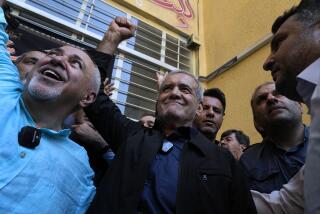A widow’s look at a shah’s legacy
- Share via
History used to be written by the victors. To the growing literary canon penned by history’s losers, add the new memoir by Farah Pahlavi, the widow of the ousted shah of Iran.
“An Enduring Love: My Life With the Shah” is not a dishy, inside-the-palace expose with the kind of tidbits served up by the clandestine Saudi princess or Osama bin Laden’s sister-in-law. It wasn’t smuggled out of the gender underground of “The Bookseller of Kabul” or “Reading Lolita in Tehran.”
There are no confessions of such titillating details as the fate of the billions of dollars that some historians say the shah spirited out of Iran when he fled in 1979.
But for anyone who watches monarchies crumble and dictatorships deconstruct and wonders What Were They Thinking, Pahlavi does provide an insular, reverential view of what novelist Gabriel Garcia Marquez calls the “solitude of power.”
Why now? Pahlavi clearly believes that Islamic fundamentalism has made the Iranian monarchy look good.
“Iranian people compare what they had before and what their country has become,” says Pahlavi, still a chic woman at 65, her telephone voice deep and smoky from an unnamed “bad habit” -- presumably smoking. “Now Iran is a center of international terrorism and fundamentalism.”
Fostering change for her 70 million compatriots back in Iran has become her raison d’exile, says Pahlavi, who splits her time between residences in Paris and Potomac, Md.
“From morning to night I am busy,” Pahlavi says, in her accented English. “To be their voice, especially for the Iranian women who are suffering so much under this regime. To be the voice of so many Iranians.”
To some, Pahlavi may seem an unlikely spokeswoman.
Pahlavi was 21 when she married Mohammed Reza Pahlavi in December 1959. She wore a 5-pound tiara designed by jeweler Harry Winston. Parisian stylists flew in to fix her hair.
The shah’s previous two marriages, Pahlavi recalls, had notoriously failed to provide him with an heir. Pahlavi says Iranians like her were moved by “the despair that descended” on the shah’s marriage to his second wife, Soraya, “the anguish Soraya felt at not being able to give the king -- and the queen mother -- the heir they hoped for,” and the sadness of their divorce.
Pahlavi asked her royal dressmakers to sew a blue hem onto one dress “so that the good fairies would at last give the king the son he so desired.” When their son Reza was born 11 months later, the shah ordered a 21-gun salute.
“People were laughing and crying,” she writes. “There was dancing in the streets of Tehran.” There were other sentiments at large, of course. And providing a royal heir was not first and foremost on the minds of all Iranians.
But if Pahlavi resists being spun as Cinderella, her book casts the complex geopolitical drama she shared with the shah as something of a tragic fairy tale. She downplays human rights abuses of the era, suggesting anti-shah protesters splashed themselves with sheep’s blood, rather than the blood of fellow protesters, and she mostly defends the shah’s hated secret police, the SAVAK, calling one SAVAK chief “a man of great culture, intelligence and humanity.”
“The SAVAK had to keep the security and stability of the country,” Pahlavi says. “It was during the Cold War. The Soviets always dreamed of reaching into the warm waters of the Persian Gulf. Many of the [shah’s] opposition were trained in Lebanon and Cuba.”
“At the same time, there were maybe excesses that were wrong and not defendable,” she says. “But then again, there was always a lot of exaggeration.”
Her book gives short shrift to a key chapter in Iranian history. Seven years before the birth of her first son, in 1953, the shah had been more firmly ensconced in his throne by a CIA-orchestrated coup against the popular, democratically elected Iranian prime minister, Mohammad Mossadegh, who had planned to nationalize the Iranian oil industry.
Many analysts blame the coup -- “Operation Ajax” to the CIA -- for setting the stage for the events that led to the Iranian revolution, and for providing kindling for an eventual firestorm of regional religious fascism and terrorism.
“It is not far-fetched to draw a line from Operation Ajax through the shah’s repressive regime and the Islamic Revolution to the fireballs that engulfed the World Trade Center in New York,” writes Stephen Kinzer in “All the Shah’s Men.”
In her memoir, Pahlavi has a slightly different take on the 1953 coup.
“At last the news that [the prime minister’s] house has been destroyed,” she writes. “The next day the king returned to Tehran to great applause.”
And six years later, while studying architecture in Paris, Pahlavi met the shah at a reception, and, after a whirlwind courtship, he proposed.
She would provide the shah with two sons and two daughters. In their glory days, they traveled the world, and Pahlavi was flattered when someone told her that French President Charles de Gaulle reportedly said her “impish quality” impressed him more than the cool poise of Jackie Kennedy.
Pahlavi also traveled throughout Iran, focusing on women’s issues. By this time, she notes, the Iranian monarchy had raised the female age of marriage to 18, given women the right to vote and, for a brief time, attempted to ban the practice of veiling.
In 1967, the shah held his coronation ceremony and took the novel step of crowning Pahlavi as his regent (the Parisian house of Van Cleef and Arpels made the crown), meaning that if anything happened to the shah, Pahlavi would be in charge of Iran until their oldest son turned 20.
By then, Iran’s growing oil riches, while they financed the construction of schools and hospitals, had widened the gap between wealthy and poor, and the shah’s lavish festivities were less well-received in the court of public opinion.
Pahlavi seems sincerely mystified and hurt by the growing public rancor, ascribing it to communism, religious fanaticism and even agitation by the foreign press. In 1977, when she and the shah visited the Carter White House, they were stunned at the protesters awaiting them.
“President Carter and his wife begged us to forget the incident -- they were truly embarrassed -- but I thought to myself that in Richard Nixon’s time the demonstrators would never have been allowed to come so close to us,” she writes.
By this time, the end was near.
“Mohammed Reza Shah became increasingly isolated and dictatorial,” Kinzer wrote. “He crushed dissent by whatever means necessary and spent huge amounts of money on weaponry -- $10 billion in the United States alone between 1972 and 1976.”
“When Iranians’ anger began boiling over in the late 1970s, the shah found that since he had crushed all legitimate political parties and other opposition groups, there was no one with whom he could negotiate a compromise,” Kinzer wrote.
When the royal family finally fled, Pahlavi writes, their palace servants wept and begged them to take them. Though Pahlavi does not mention this, the servants certainly had reason to fear revolutionary firing squads, which would quickly dispatch anyone connected with the shah’s government.
Pahlavi denies accounts that the family helped themselves to the national treasury.
“This is completely false. It’s the propaganda of the Islamic republic,” she says. “My husband was a patriot. He cared about his country. He was not interested in financial matters. He fought for liberty and wanted to open up the society to political participation.”
The rest, of course, is history.
The Ayatollah Khomeini, arrested and sent into exile by the shah in 1964, reemerged, saying: “Islam is all that remains.”
After President Carter allowed the shah into the United States, Iranian radicals, apparently fearing the shah would be restored, stormed the U.S. Embassy in Tehran and seized 52 U.S. hostages, holding them for 14 months.
“The world was fooled by the promises of Khomeini,” Pahlavi says. “They thought religious men would open the door to paradise, and they opened the door to hell.”
But history did not absolve the shah, either.
His nephew was assassinated by a motorcycle commando outside his Paris villa not long after the shah fled Iran. Someone scrawled “miserable parasite” on the grave of his second wife, Soraya, in Germany. His eldest daughter, Farahnaz, tried for a while to get work at such international aid agencies as UNICEF and was rejected “because of her name,” Pahlavi says.
The shah and his family, hounded from the United States, Mexico, Panama, the Bahamas and Morocco, finally settled in Egypt, where he succumbed to cancer in 1980.
The shah’s heir, Reza Pahlavi, now calls himself shah, and envisions returning to Iran under a constitutional monarchy.
Pahlavi, who still goes by “her majesty queen,” remains a controversial figure among Iranian exiles, and Iranian academics doubt her book will do much to change that.
“There is a Marie Antoinette line about ‘Let them eat cake,’ ” says Farideh Farhi, a political scientist who teaches at the University of Hawaii. “She’s not that bad. But there is a certain degree of oblivion to what brought this anger toward the Pahlavi dynasty.”
Unable to appear in bookstores because of security risks, she has not yet been invited to Los Angeles by the kind of exclusive private club that can guarantee her safety, like her sold-out appearance at San Francisco’s Commonwealth Club next week.
Pahlavi says she began her book after her youngest daughter, Leila, died in a London hotel room after a long struggle with depression and sleeping pills. She is aided these days by an assistant, a secretary, a driver and a cook -- a far cry from her entourage in Tehran, where she had a staff of 60.
“I have to do a lot of things myself,” she says. “I can’t say I don’t have a comfortable life, but according to my responsibilities to my compatriots, the life I’m living is not easy.”
More to Read
Sign up for our Book Club newsletter
Get the latest news, events and more from the Los Angeles Times Book Club, and help us get L.A. reading and talking.
You may occasionally receive promotional content from the Los Angeles Times.










